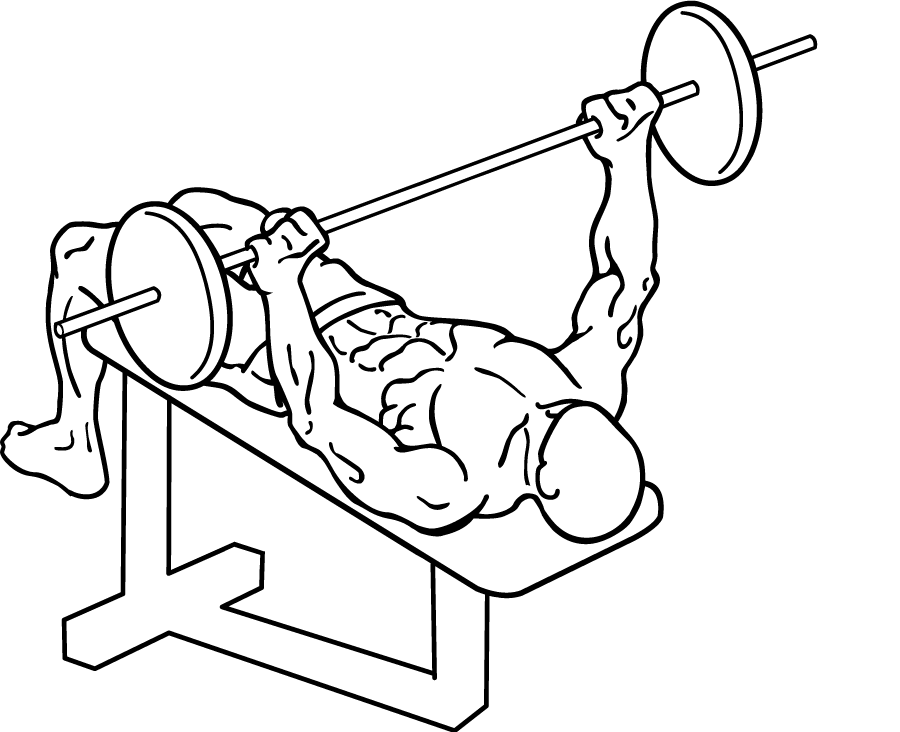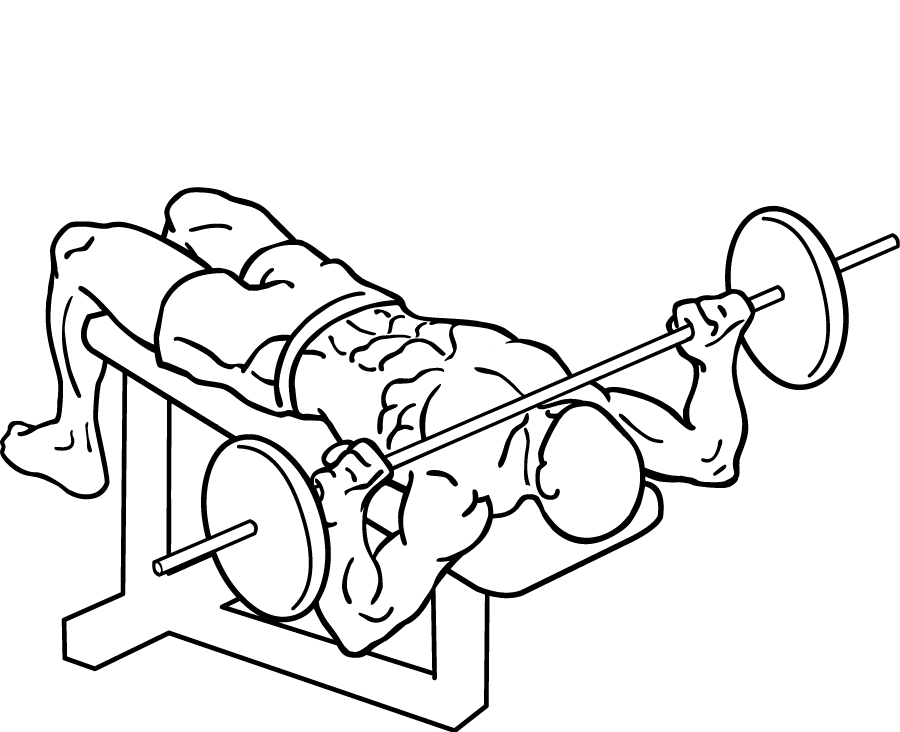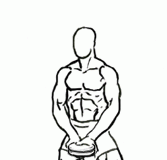Last Updated on September 25, 2014
If you’re ready to take your chest workouts to the next level, the Barbell Neck Press is one exercise that deserves a spot in your routine. This advanced movement targets the upper chest muscles while also activating the shoulders and triceps. It’s not for beginners, but with the proper form and gradual weight progression, you can safely and effectively incorporate it into your strength training program.
In this blog post, we’ll cover everything you need to know about the Barbell Neck Press: from why it’s an excellent choice for chest development to step-by-step instructions on how to perform the exercise. We’ll also discuss safety tips, common mistakes to avoid, and how it compares to other chest exercises like the traditional bench press. So let’s dive in!
What is the Barbell Neck Press?
The Barbell Neck Press, sometimes referred to as the “Guillotine Press,” is a variation of the bench press that shifts the focus more towards the upper chest, or clavicular head of the pectoralis major. Unlike the standard bench press, where the bar is lowered to the mid-chest area, the Barbell Neck Press targets the upper chest by lowering the bar towards the neck. This small adjustment in bar path creates a unique stimulus for muscle growth and strength.
Though this movement is highly effective at isolating the upper chest, it comes with some risk. The barbell is lowered near the neck, so it’s crucial to use proper form to avoid injury. It’s also recommended to start with lighter weights and, if possible, have a spotter assist you, especially when going heavy.
Why Should You Include the Barbell Neck Press in Your Routine?
Adding the Barbell Neck Press to your chest workout can provide several benefits. Let’s explore the primary reasons why this exercise is worth considering:
1. Emphasizes Upper Chest Development
One of the main goals for many lifters is to achieve a well-rounded, balanced chest. While exercises like the standard bench press are great for overall chest development, the Barbell Neck Press specifically targets the upper portion of the pectoral muscles. For those looking to create that impressive chest definition and fill out their upper chest, this is one of the best exercises to help achieve that goal.
2. Strengthens the Shoulders and Triceps
Though the primary focus is on the chest, the Barbell Neck Press also engages the shoulders and triceps. As you press the barbell upwards, your anterior deltoids and triceps are activated, adding to the overall strength-building benefits of this movement.
3. Improves Stability and Control
Since the bar path is slightly different than the traditional bench press, the Barbell Neck Press requires more control and stability throughout the movement. As a result, it helps improve your muscle coordination and balance, which can translate to better performance in other exercises and functional movements.
4. Enhances Upper Body Strength
With regular practice, the Barbell Neck Press will significantly boost your upper body strength, particularly in the chest, shoulders, and triceps. Increased strength in these areas not only improves your aesthetic appearance but also contributes to better performance in sports and daily activities that involve pushing or pressing movements.
5. Provides Variety to Your Chest Routine
It’s easy to fall into a routine of doing the same exercises over and over again. While consistency is key to progress, incorporating different variations of movements can prevent plateaus and keep your workouts fresh. The Barbell Neck Press provides a unique twist to your chest routine, offering a new challenge for your muscles and promoting continued growth.
How to Perform the Barbell Neck Press: Step-by-Step Guide
Now that you know why the Barbell Neck Press is such a valuable exercise, let’s break down the proper form so you can perform it safely and effectively. Follow these steps closely to ensure you’re getting the most out of the movement while minimizing the risk of injury.
Step 1: Setup
- Equipment: You’ll need a flat bench and a barbell loaded with an appropriate amount of weight. Remember, since this is an advanced movement, it’s best to start with lighter weights than you would use for a regular bench press.
- Position: Lie flat on the bench with your feet planted firmly on the floor. Ensure your lower back maintains a slight natural arch, and your shoulder blades are retracted (pinched together) to create a stable base.
Step 2: Grip the Barbell
- Grip width: Grasp the barbell with a grip that is slightly wider than shoulder-width. Your hands should be positioned evenly on the bar, ensuring balance throughout the movement. This wider grip is essential as it helps to engage the upper chest more effectively.
Step 3: Lift the Barbell to Starting Position
- With your grip in place, unrack the barbell and move it above your body, positioning it directly over your upper chest. The barbell should be aligned with your clavicle (collarbone) rather than the mid-chest as in a traditional bench press. This is your starting position.
Step 4: Lower the Barbell
- Begin lowering the barbell slowly and under control. The key here is to bring the barbell down towards your neck, just above the top of your chest. Caution: Do not actually touch your neck with the bar. Aim to bring the bar as close as possible without compromising your safety or comfort.
- Keep your elbows flared out wide to the sides as you lower the bar. This elbow positioning emphasizes the upper chest and prevents the triceps from taking over the movement.
Step 5: Press the Barbell Up
- Once the barbell reaches the desired point near your neck, pause for a brief moment. Then, press the bar upwards by driving through your chest and shoulders. Continue pressing until your arms are fully extended, and your elbows are locked out.
- Be sure to maintain control throughout the lift and avoid letting the bar sway forward or backward. The movement should be smooth and controlled.
Step 6: Repeat for Desired Repetitions
- After locking out your elbows at the top, return the barbell to the starting position and repeat the movement for your desired number of repetitions. For muscle growth, aim for 3–4 sets of 8–12 reps.
Safety Tips for the Barbell Neck Press
The Barbell Neck Press is effective but does come with potential risks due to the bar’s proximity to your neck and the load it places on the shoulders. Here are some important safety tips to consider:
- Start with Light Weight: Don’t go heavy on this exercise right away, especially if you’re unfamiliar with it. Start with an empty bar or light weights until you master the form.
- Warm Up Properly: Ensure your chest, shoulders, and triceps are warmed up thoroughly before performing this exercise. A proper warm-up helps prevent injuries by preparing your muscles and joints for the workload.
- Use a Spotter: Whenever possible, perform the Barbell Neck Press with a spotter, especially if you’re lifting heavy. A spotter can help ensure your safety and give you confidence during the exercise.
- Avoid Bouncing the Bar: Never bounce the bar off your chest or neck. Always control the descent and ascent to prevent injury.
- Keep Your Shoulders Stable: Retract your shoulder blades and keep them retracted throughout the entire movement. This stabilizes your shoulder joint and reduces the risk of shoulder injuries.
- Stop If You Feel Discomfort: If you experience pain in your shoulders, neck, or chest during the movement, stop immediately. Pushing through pain could lead to serious injury.
Common Mistakes to Avoid
Like any exercise, the Barbell Neck Press is most effective when performed with the correct form. To ensure you’re doing it right, here are some common mistakes to avoid:
- Using Too Much Weight: It’s tempting to load up the bar, but using too much weight too soon is a recipe for poor form and injury. Focus on form first, and then gradually increase the weight.
- Letting the Elbows Drop: One of the most common mistakes is letting your elbows drop too low, which can reduce the effectiveness of the exercise and shift the load onto your triceps. Keep your elbows flared out to maintain the focus on your chest.
- Incorrect Bar Path: Lowering the bar to your mid-chest instead of your upper chest or neck area turns the movement into a standard bench press. Make sure the bar path stays aligned with your upper chest throughout the movement.
- Arching Your Lower Back Excessively: While a slight arch in the lower back is natural and helps protect the spine, excessive arching can lead to lower back strain. Focus on keeping your core engaged and maintain a neutral spine position.
- Not Using Full Range of Motion: Don’t shortchange yourself by performing half-reps. Make sure you’re lowering the bar close to your neck and fully extending your arms at the top of the lift for maximum results.
Barbell Neck Press vs. Bench Press: Which is Better?
While both the Barbell Neck Press and the traditional bench press are great exercises for building chest strength, they serve slightly different purposes. Here’s a quick comparison:
- Barbell Neck Press: Targets the upper chest more specifically. It requires greater control and places more emphasis on stability. Best for those looking to improve upper chest development and diversify their chest routine.
- Bench Press: A classic compound movement that works the entire chest, shoulders, and triceps. Great for overall strength building and is typically performed with heavier weights.
Incorporating both into your routine can provide balanced chest development and overall strength gains.
The Barbell Neck Press is an excellent advanced exercise for those looking to emphasize upper chest development while also working the shoulders and triceps. With the right form, proper precautions, and a gradual progression in weight, you can make this movement a staple in your chest workouts.
Remember to always prioritize safety by warming up properly, using appropriate weights, and employing a spotter when necessary. By mastering the Barbell Neck Press, you’ll be well on your way to achieving a stronger, more defined upper chest and improving your overall upper body strength.








